 LACE MONITOR Varanus varius (White, ex Shaw, 1790)
LACE MONITOR Varanus varius (White, ex Shaw, 1790)
The Lace Monitor is one of Australia's largest lizards with some large males sometimes exceeding 2 metres in length. Specimens are usually a greyish black in colour with thin irregular bands crossing the body. There is, however, a colour form which is common in most drier areas where the colour consists of distinct broad yellow and black bands. These lizards also have a different head morphology from the other specimens, with which they regularly interbreed.
I have had it suggested to me that the cause of the banded colour phase is a sex-linked gene, that only expresses itself in males, but further investigation has shown females of this colour phase to exist as well. In general, intermediate colour phases do not occur, adding credibility to the theory given, although for a number of years I have held a female of apparently intermediate colour.
The Lace Monitor occurs in wooded areas of eastern Australia from north Queensland through New South Wales, Victoria and far south-eastern South Australia.
This lizard is both a ground and tree-dweller, but it will immediately run up the first vertical object when disturbed. The Lace Monitor has been known to run up a human, when the person had been standing still.
Despite its size the Lace Monitor is a very shy lizard in the wild. It feeds on all forms of carrion and can go for very long periods without fond if necessary. In cattle country where food is apparently fairly abundant some specimens become extremely obese.
The males are by far the larger sex, and seem to be the most common in the wild. During the spring mating season, males will fight by clawing and biting, sometimes even mortally wounding one another. Most large males carry many scars from previous fights. These fights often appear to be initiated by the presence of a female to the males, who otherwise do not seem to be territorial.
About six to twenty eggs are laid in termite mounds, usually in trees.
The above was from the book Australian Reptiles and Frogs by Raymond Hoser and now available on a fantastic CD-Rom along with a vast amount of other information, papers and the like on reptiles, frogs and other wildlife.